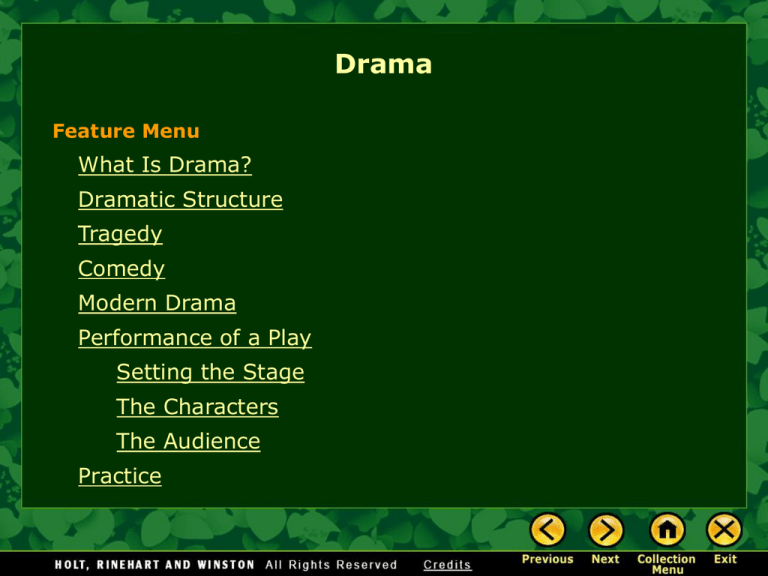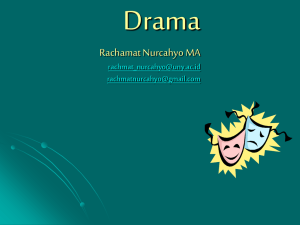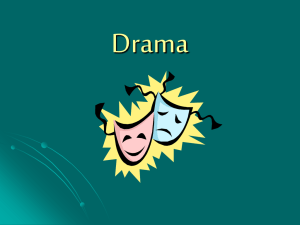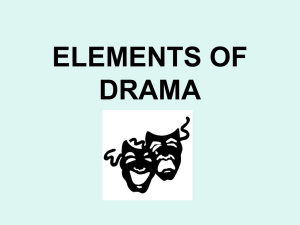Elements of Literature: Character
advertisement

Drama Feature Menu What Is Drama? Dramatic Structure Tragedy Comedy Modern Drama Performance of a Play Setting the Stage The Characters The Audience Practice What Is Drama? A drama is a story enacted onstage for a live audience. Origins of Drama [End of Section] Dramatic Structure Like the plot of a story, the plot of a play involves characters who face a problem or conflict. Complications tension builds Exposition characters and conflict are introduced Climax point of highest tension; action determines how the conflict will be resolved Resolution conflict is resolved; play ends [End of Section] Tragedy A tragedy is a play that ends unhappily. • Most classic Greek tragedies deal with serious, universal themes such as right and wrong justice and injustice life and death • Tragedies pit human limitations against the larger forces of destiny. Tragedy The protagonist of most classical tragedies is a tragic hero. This hero • is noble and in many ways admirable • has a tragic flaw, a personal failing that leads to a tragic end pride rebelliousness jealousy [End of Section] Comedy A comedy is a play that ends happily. The plot usually centers on a romantic conflict. boy meets girl Modern comedies boy loses girl boy wins girl Comedy The main characters in a comedy could be anyone: nobility townspeople servants Comedy • Comic complications always occur before the conflict is resolved. • In most cases, the play ends with a wedding. Comedy Quick Check MABEL CHILTERN. How horrid you have been! You have never talked to me the whole evening! LORD GORING. How could I? You went away with the child-diplomatist. MABEL CHILTERN. You might have followed us. Pursuit would have been only polite. I don't think I like you at all this evening! How can you tell this play is a comedy? What is the most likely outcome? LORD GORING. I like you immensely. from An Ideal Husband by Oscar Wilde [End of Section] Modern Drama A modern play • may be tragedy, comedy, or a mixture of the two • usually focuses on personal issues • usually is about ordinary people Modern Drama Modern playwrights often experiment with unconventional plot structures. long flashbacks music visual projections of a character’s private thoughts [End of Section] Performance of a Play When you read a play, remember that it is meant to be performed for an audience. Stage Directions Performance Playwright describes setting and characters’ actions and manner. • Theater artists bring the playwright’s vision to life on the stage. [Wyona is sitting on the couch. She sees Paul and jumps to her feet.] Wyona. [Angrily.] What do you want? • The audience responds to the play and shares the experience. [End of Section] Setting the Stage Stages can have many different sizes and layouts. “Thrust” stage • The stage extends into the viewing area. • The audience surrounds the stage on three sides. Stages in Shakespeare’s time Setting the Stage “In the round” stage is surrounded by an audience on all sides. Setting the Stage Proscenium stage • The playing area extends behind an opening called a “proscenium arch.” • The audience sits on one side looking into the action. upstage stage right stage left downstage Setting the Stage Scene design transforms a bare stage into the world of the play. Scene design consists of • sets • lighting • costumes • props Setting the Stage A stage’s set might be realistic and detailed abstract and minimal Setting the Stage A lighting director skillfully uses light to change the mood and appearance of the set. Setting the Stage The costume director works with the director to design the actors’ costumes. • Like sets, costumes can be detailed minimal Setting the Stage Props (short for properties) are items that the characters carry or handle onstage. • The person in charge of props must make sure that the right props are available to the actors at the right moments. [End of Section] The Characters The characters’ speech may take any of the following forms. Dialogue: conversations of characters onstage Monologue: long speech given by one character to others Soliloquy: speech by a character alone onstage to himself or herself or to the audience Asides: remarks made to the audience or to one character; the other characters onstage do not hear an aside The Characters Quick Check LIZA. No: I dont want no gold and no diamonds. I'm a good girl, I am. [She sits down again, with an attempt at dignity]. HIGGINS. You shall remain so, Eliza, under the care of Mrs. Pearce. And you shall marry an officer in the Guards, with a beautiful moustache: the son of a marquis, who will disinherit him for marrying you, but will relent when he sees your beauty and goodness— from Pygmalion by Bernard Shaw What are the stage directions in this passage? What does the characters’ dialogue tell you about them? [End of Section] The Audience Finally, a play needs an audience to experience the performance understand the story respond to the characters [End of Section] Practice Choose a play or movie that you remember seeing, and discuss its dramatic elements. 1. Describe the stage set or sets. 2. Indicate who the characters are and what their relationship is. 3. Evaluate the characters’ dialogue. Does it make clear what the characters want and why they are having trouble getting it? 4. Write a few of the stage directions, based on what you imagine them to have been. [End of Section] The End









